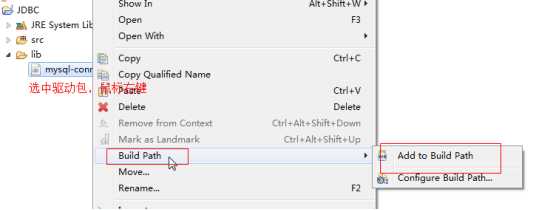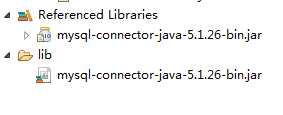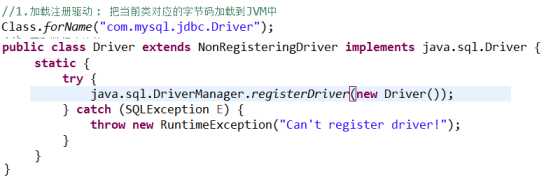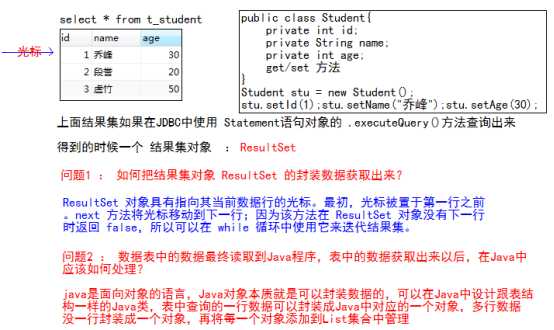1.jdbc概述
问题:实际开发中,不可能用工具或者命令行操作数据库,数据库表中的数据最终要使用Java程序来操作,那么Java中如何操作数据库中的数据呢?
答 : 在Java语言中,有一个专门连接数据库的规范(JDBC),专门负责连接数据库进行数据操作的规范
JDBC只是SUN编写的一堆接口(规范的体现),SUN公司自己并没有实现
问题 : 为什么SUN只定义一个JDBC规范,而不实现呢?
答 : 因为市面上的数据库很多,每个数据库内部接口不会向外暴露,而且即便是暴露让SUN去实现,市面上很多数据库全部要SUN来实现不现实
实际中哪个数据库需要支持JAVA语言,就需要自己实现Java的JDBC规范,因为实现了JDBC很多接口,那么就会有很多实现类,而很多实现类在java中会使用一个专门的包封装起来,叫做jar包(在JDBC中叫做驱动包),各大数据库产商实现JDBC规范以后都会把他们jar包放在官网上以供开发者下载使用
DBC(Java DataBase Connectivity):是一种用于执行SQL语句的Java API,可以为多种关系数据库提供统一访问,它由一组用Java语言编写的类和接口组成。JDBC提供了一种基
JDBC规范对应的api包

2. 入门案例
1)连接数据库
案例使用JDBC操作MySQL数据库
2)创建普通java项目


4) 将MySQL驱动包拷贝到项目中并添加依赖


5) 获取数据库连接对象
准备:
1.拷贝MySQL的驱动包到项目中去:mysql-connector-java-5.1.x-bin.jar
2.build path,告速项目去哪里去找字节码文件.
--------------------------------------------------------------------------------
操作JDBC的第一步,获取JDBC的连接对象.:Connection.
步骤:
1.加载注册驱动.
就是把驱动中的Driver字节码加载到JVM中.
Class.forName("com.mysql.jdbc.Driver");
为什么这句话就可以加载注册驱动?
第一步:把com.mysql.jdbc.Driver.class这份字节码加载到JVM中.
第二步:当一份字节码被加载进JVM,马上就会执行该字节码中的静态代码块.
第三步:该静态代码中,就在完成,先创建驱动对象,再注册.
2.通过DriverManager获取连接对象.
public static Connection getConnection(String url,String user,String password)
Connection conn = DriverManager.getConnection("jdbc:mysql://localhost:3306/dbName","root","admin");
jdbc:mysql://localhost:3306/dbName
jdbc:mysql:// :连接MySQL数据库的协议,不同数据库协议不一样
localhost:3306 :数据库软件的主机和端口
dbName : 具体要连接数据库
若数据库安装在本机,并且端口是默认的3306,则可以简写:
Connection conn = DriverManager.getConnection("jdbc:mysql:///dbName","root","admin");
验证已经获取连接:可以在MySQL控制台,使用命令:show processlist; 查看MySQL运行进程.

1 public class GetConnectionDemo { 2 3 public static void main(String[] args) throws Exception { 4 5 6 7 //1.加载注册驱动 : 把当前类对应的字节码加载到JVM中 8 9 Class.forName("com.mysql.jdbc.Driver"); 10 11 //2.获取数据库连接 12 13 Connection conn = DriverManager.getConnection("jdbc:mysql://localhost:3306/jdbcdemo", "root", "root"); 14 15 System.out.println(conn); 16 17 18 19 } 20 21 }
在其他操作之间先要把数据库表要创建出来
|
创建一张t_student表: id: name: age: |
1 /* 2 3 * 4 5 * 创建表操作 6 7 * SQL : create table t_student (id int primary key auto_increment,name varchar(50),age int) 8 9 */ 10 11 12 13 public static void main(String[] args) throws Exception { 14 15 String sql = "create table t_student (id int primary key auto_increment,name varchar(50),age int)"; 16 17 //贾琏欲执事 18 19 //1,加载注册驱动 20 21 Class.forName("com.mysql.jdbc.Driver"); 22 23 //2,获取数据库连接 24 25 Connection conn = DriverManager.getConnection("jdbc:mysql://localhost:3306/jdbcdemo", "root", "root"); 26 27 //3,创建语句对象(用于执行SQL语句的对象) 28 29 Statement st = conn.createStatement(); 30 31 //4, 执行SQL语句 32 33 //int rows = st.executeUpdate(String sql);执行DDL和DML语句,放回的是受影响的行数 34 35 //ResultSet res = st.executeQuery(String sql);执行DQL查询语句,返回的结果集对象 36 37 st.executeUpdate(sql); 38 39 //5,释放资源(先开后关) 40 41 st.close(); 42 43 conn.close(); 44 45 }
1 //DML : 对表数据的增删改操作 2 3 public class DMLDemo { 4 5 6 7 /* 8 9 * 向 t_student表中插入一条数据 10 11 * sql : insert into t_student(name,age) values (‘乔峰‘,30) 12 13 */ 14 15 @Test 16 17 public void testInsert() throws Exception { 18 19 String sql = "insert into t_student(name,age) values (‘乔峰‘,30)"; 20 21 22 23 // 1.加载注册驱动 24 25 Class.forName("com.mysql.jdbc.Driver"); 26 27 28 29 // 2.获取数据库连接对象 30 31 Connection conn = DriverManager.getConnection("jdbc:mysql://localhost:3306/jdbcdemo", "root", "root"); 32 33 // 3.创建语句对象 34 35 Statement st = conn.createStatement(); 36 37 38 39 // 4.执行SQL语句 40 41 // int rows = st.executeUpdate(String sql);执行DDL和DML语句,放回的是受影响的行数 42 43 // ResultSet res = st.executeQuery(String sql);执行DQL查询语句,返回的结果集对象 44 45 int rows = st.executeUpdate(sql); 46 47 System.out.println(rows); 48 49 //5.释放资源(先开后关) 50 51 st.close(); 52 53 conn.close(); 54 55 56 57 } 58 59 /* 60 61 * 删除操作: 删除t_student表中的某一条数据 62 63 * SQL :delete from t_student where id = 2 64 65 */ 66 67 @Test 68 69 public void testDelete() throws Exception { 70 71 String sql = "delete from t_student where id = 2"; 72 73 74 75 // 1.加载注册驱动 76 77 Class.forName("com.mysql.jdbc.Driver"); 78 79 80 81 // 2.获取数据库连接对象 82 83 Connection conn = DriverManager.getConnection("jdbc:mysql://localhost:3306/jdbcdemo", "root", "root"); 84 85 // 3.创建语句对象 86 87 Statement st = conn.createStatement(); 88 89 90 91 // 4.执行SQL语句 92 93 // int rows = st.executeUpdate(String sql);执行DDL和DML语句,放回的是受影响的行数 94 95 // ResultSet res = st.executeQuery(String sql);执行DQL查询语句,返回的结果集对象 96 97 int rows = st.executeUpdate(sql); 98 99 System.out.println(rows); 100 101 //5.释放资源(先开后关) 102 103 st.close(); 104 105 conn.close(); 106 107 } 108 109 /* 110 111 * 修改操作 : 修改t_student表中的某一条数据 112 113 * SQL : update t_student set name = ‘虚竹‘,age = 50 where id = 3 114 115 */ 116 117 @Test 118 119 public void testUpdate() throws Exception { 120 121 String sql = "update t_student set name = ‘虚竹‘,age = 50 where id = 3"; 122 123 124 125 // 1.加载注册驱动 126 127 Class.forName("com.mysql.jdbc.Driver"); 128 129 130 131 // 2.获取数据库连接对象 132 133 Connection conn = DriverManager.getConnection("jdbc:mysql://localhost:3306/jdbcdemo", "root", "root"); 134 135 // 3.创建语句对象 136 137 Statement st = conn.createStatement(); 138 139 140 141 // 4.执行SQL语句 142 143 // int rows = st.executeUpdate(String sql);执行DDL和DML语句,放回的是受影响的行数 144 145 // ResultSet res = st.executeQuery(String sql);执行DQL查询语句,返回的结果集对象 146 147 int rows = st.executeUpdate(sql); 148 149 System.out.println(rows); 150 151 //5.释放资源(先开后关) 152 153 st.close(); 154 155 conn.close(); 156 157 } 158 159 }
5.DQL操作-查询操作

2)查询具体操作
结果集的列的位置

使用 rs.next() 偏移光标,循环指定具体的某一行
获取数据的具体方法
|
getObject(int columnIndex) |
|
|
getObject(String columnLabel) |
1 package cn.sxt.jdbc._01connection; 2 3 4 5 6 7 import java.sql.Connection; 8 9 import java.sql.DriverManager; 10 11 import java.sql.ResultSet; 12 13 import java.sql.Statement; 14 15 import java.util.ArrayList; 16 17 import java.util.List; 18 19 20 21 import org.junit.Test; 22 23 24 25 //DQL :查询操作 26 27 public class D_DQLDemo { 28 29 30 31 /* 32 33 * 多行查询 :查询t_student表中的所有数据 34 35 * SQL : select * from t_student 36 37 */ 38 39 @Test 40 41 public void testList() throws Exception { 42 43 String sql = "select * from t_student"; 44 45 46 47 // 1.加载注册驱动 48 49 Class.forName("com.mysql.jdbc.Driver"); 50 51 52 53 // 2.获取数据库连接对象 54 55 Connection conn = DriverManager.getConnection("jdbc:mysql://localhost:3306/jdbcdemo", "root", "root"); 56 57 // 3.创建语句对象 58 59 Statement st = conn.createStatement(); 60 61 62 63 // 4.执行SQL语句 64 65 // int rows = st.executeUpdate(String sql);执行DDL和DML语句,放回的是受影响的行数 66 67 // ResultSet res = st.executeQuery(String sql);执行DQL查询语句,返回的结果集对象 68 69 ResultSet rs = st.executeQuery(sql); 70 71 72 73 74 75 //创建list集合用于封装Student对象 76 77 List<Student> stus = new ArrayList<>(); 78 79 80 81 while(rs.next()) { 82 83 //1.通过结果集的位置获取对应的数 84 85 /*Object id = rs.getObject(1); 86 87 Object name = rs.getObject(2); 88 89 Object age = rs.getObject(3);*/ 90 91 92 93 //2.通过结果集的 列名获取对应的数据 94 95 /*Object id = rs.getObject("id"); 96 97 Object name = rs.getObject("name"); 98 99 Object age = rs.getObject("age");*/ 100 101 //3.通过数据库数据和Java对应的数据类型获取对应的只 102 103 int id = rs.getInt("id"); 104 105 String name = rs.getString("name"); 106 107 int age = rs.getInt("age"); 108 109 //System.out.println(id+","+name+","+age); 110 111 112 113 //将获取的数据封装成对应的Student对象 114 115 Student stu = new Student(id, name, age); 116 117 118 119 //将一个个Student对象添加到list集合中 120 121 stus.add(stu); 122 123 } 124 125 126 127 for (Student student : stus) { 128 129 System.out.println(student); 130 131 } 132 133 //5.释放资源(先开后关) 134 135 rs.close(); 136 137 st.close(); 138 139 conn.close(); 140 141 } 142 143 144 145 146 147 /* 148 149 * 单行查询: 查询出t_student 指定id的信息 150 151 * SQL : select * from t_student where id = 1; 152 153 */ 154 155 @Test 156 157 public void testGetOne() throws Exception { 158 159 String sql = "select * from t_student where id = 2"; 160 161 162 163 // 1.加载注册驱动 164 165 Class.forName("com.mysql.jdbc.Driver"); 166 167 168 169 // 2.获取数据库连接对象 170 171 Connection conn = DriverManager.getConnection("jdbc:mysql://localhost:3306/jdbcdemo", "root", "root"); 172 173 // 3.创建语句对象 174 175 Statement st = conn.createStatement(); 176 177 178 179 // 4.执行SQL语句 180 181 // int rows = st.executeUpdate(String sql);执行DDL和DML语句,放回的是受影响的行数 182 183 // ResultSet res = st.executeQuery(String sql);执行DQL查询语句,返回的结果集对象 184 185 ResultSet rs = st.executeQuery(sql); 186 187 188 189 if(rs.next()) { 190 191 //1.通过结果集的位置获取对应的数 192 193 /*Object id = rs.getObject(1); 194 195 Object name = rs.getObject(2); 196 197 Object age = rs.getObject(3);*/ 198 199 200 201 //2.通过结果集的 列名获取对应的数据 202 203 /*Object id = rs.getObject("id"); 204 205 Object name = rs.getObject("name"); 206 207 Object age = rs.getObject("age");*/ 208 209 //3.通过数据库数据和Java对应的数据类型获取对应的只 210 211 int id = rs.getInt("id"); 212 213 String name = rs.getString("name"); 214 215 int age = rs.getInt("age"); 216 217 //System.out.println(id+","+name+","+age); 218 219 220 221 //将获取的数据封装成对应的Student对象 222 223 Student stu = new Student(id, name, age); 224 225 System.out.println(stu); 226 227 } 228 229 //5.释放资源(先开后关) 230 231 rs.close(); 232 233 st.close(); 234 235 conn.close(); 236 237 } 238 239 }
6.预编译语句对象PreparedStatment
问题 : 我们有了Statment对象可以执行SQL,为什么还要使用PreparedStatment?
优势
1. SQL语句结构清晰,参数的设置和SQL语句分离
2. 性能更高
3. 防止SQL注入
|
Statement: 表示静态SQL语句对象. PreparedStatement:Statement的子接口,表示预编译SQL语句对象. 通过占位符(?)来拼SQL. |
创建语句对象 Statment
|
createStatement() |
创建预编译语句对象PreparedStatement
|
prepareStatement(String sql) |

2)执行SQL语句的方法
在执行SQL语句的时候回带上SQL语句
|
executeQuery(String sql) |
|
|
int |
executeUpdate(String sql) |
[2]PreparedStatement
在执行SQL语句的方法中不需要设置SQL语句
|
executeQuery() |
|
|
int |
executeUpdate() |
|
void setXxx(int parameterIndex,Xxx value):用于设置占位符参数, parameterIndex:第几个问号. 注意:从1开始. value:设置的真实值. Xxx:表示数据类型.String/int/long/Double |
1 package cn.sxt.jdbc._01connection; 2 3 4 5 import static org.junit.Assert.*; 6 7 8 9 import java.sql.Connection; 10 11 import java.sql.DriverManager; 12 13 import java.sql.PreparedStatement; 14 15 16 17 import org.junit.Test; 18 19 20 21 //DML : 对表数据的增删改操作,使用预编译语句对象 22 23 public class E_DMLByPreparedStatmentDemo { 24 25 26 27 /* 28 29 * 向 t_student表中插入一条数据 30 31 * sql : insert into t_student(name,age) values (‘乔峰‘,30) 32 33 */ 34 35 @Test 36 37 public void testInsert() throws Exception { 38 39 String sql = "insert into t_student(name,age) values (?,?)"; 40 41 42 43 // 1.加载注册驱动 44 45 Class.forName("com.mysql.jdbc.Driver"); 46 47 48 49 // 2.获取数据库连接对象 50 51 Connection conn = DriverManager.getConnection("jdbc:mysql://localhost:3306/jdbcdemo", "root", "root"); 52 53 // 3.创建预编译语句对象 54 55 PreparedStatement ps = conn.prepareStatement(sql); 56 57 //3.1设置占位符参数 58 59 ps.setString(1, "东方姑娘"); 60 61 ps.setInt(2, 18); 62 63 64 65 // 4.执行SQL语句:注意不要带SQL参数 66 67 ps.executeUpdate(); 68 69 //5.释放资源(先开后关) 70 71 ps.close(); 72 73 conn.close(); 74 75 76 77 } 78 79 /* 80 81 * 删除操作: 删除t_student表中的某一条数据 82 83 * SQL :delete from t_student where id = 2 84 85 */ 86 87 @Test 88 89 public void testDelete() throws Exception { 90 91 String sql = "delete from t_student where id = ?"; 92 93 94 95 // 1.加载注册驱动 96 97 Class.forName("com.mysql.jdbc.Driver"); 98 99 100 101 // 2.获取数据库连接对象 102 103 Connection conn = DriverManager.getConnection("jdbc:mysql://localhost:3306/jdbcdemo", "root", "root"); 104 105 // 3.创建预编译语句对象 106 107 PreparedStatement ps = conn.prepareStatement(sql); 108 109 //3.1设置占位符对应的参数值 110 111 ps.setInt(1, 1); 112 113 114 115 // 4.执行SQL语句 116 117 int rows = ps.executeUpdate(); 118 119 System.out.println(rows); 120 121 //5.释放资源(先开后关) 122 123 ps.close(); 124 125 conn.close(); 126 127 } 128 129 /* 130 131 * 修改操作 : 修改t_student表中的某一条数据 132 133 * SQL : update t_student set name = ‘虚竹‘,age = 50 where id = 3 134 135 */ 136 137 @Test 138 139 public void testUpdate() throws Exception { 140 141 String sql = "update t_student set name = ?,age = ? where id = ?"; 142 143 144 145 // 1.加载注册驱动 146 147 Class.forName("com.mysql.jdbc.Driver"); 148 149 150 151 // 2.获取数据库连接对象 152 153 Connection conn = DriverManager.getConnection("jdbc:mysql://localhost:3306/jdbcdemo", "root", "root"); 154 155 // 3.创建预编译语句对象 156 157 PreparedStatement ps = conn.prepareStatement(sql); 158 159 //3.1设置占位符参数对应的值 160 161 ps.setString(1, "西方失败"); 162 163 ps.setInt(2, 40); 164 165 ps.setInt(3, 4); 166 167 // 4.执行SQL语句 168 169 int rows = ps.executeUpdate(); 170 171 System.out.println(rows); 172 173 //5.释放资源(先开后关) 174 175 ps.close(); 176 177 conn.close(); 178 179 } 180 181 } 182 183
原文:https://www.cnblogs.com/qq2267711589/p/10887536.html